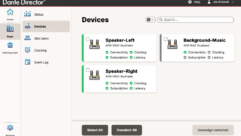Home Director Rebounds, Builds Product Line and Dealer Networks
Mar 5, 2007 12:00 PM
Tech industry veterans walking the aisles of the International Builders’ Show in Orlando saw the usual smattering of structured wiring, home control, and lighting companies hoping to grab the interested eye of production and custom home builders. They also might have caught sight of a familiar name in the structured wiring market that’s positioning itself for a rebound.
Home Director, the former IBM spinoff, exhibited at the show, four months after being approved for a bankruptcy reorganization plan. One of the early providers of a structured wiring package, Home Director has now expanded its portfolio to include home control and entertainment. The “new Home Director,” says President Mark Stiving, offers high quality at much lower cost “with new valuable features to builders and integrators.” The company is targeting new production homes—including multi-dwelling units.
Boasting a clean capitalization table and no debt, Home Director has acquired Novus, Destiny Networks, and Dedicated Devices, which bring existing products and dealer networks to the portfolio and allow Home Director to offer builders and integrators supportable and cost-effective technology products, Stiving says.
The company’s strategy is to target developers and help them make more money from service providers. “Service providers are willing to pay large developers for the rights to each lot on their properties,” Stiving says. “However, if the service provider can be assured that the home built on that lot has enough technology infrastructure to take advantage of the services, each lot is worth much more.” Home Director helps the developer make the most out of each lot, and the developer in turn makes sure Home Director products go into the homes. Stiving says the company has written deals with two developers and is in discussions with more. “The business model is working,” he says.
The Campbell, Calif.-based company currently uses six integrators to serve those developments and is seeking more. “In general, integrators have a very hard time scaling their businesses,” Stiving says. “We have a model to help integrators scale by emphasizing the things they are very good at—like trim, final and selling to homeowners at the design center—while de-emphasizing areas where they tend to struggle.”
One of the Home Director differentiators is a structured wiring can that’s field-upgradeable to double the size. Stiving says fast innovation time also sets the company apart. “All of our new products were conceived, developed, and put into production in less than four months,” he says.
The purchase of Destiny Networks last fall brought in a line of low-cost Linux-based IP home controllers which don’t require installers to learn a complex programming language. The Destiny product, Home Director says, provides a control system that can be deployed to meet the needs and budget of the average homebuyer. Early this year, Home Director bought Dedicated Devices for the company’s whole-home audio gear.
A slew of announcements in early February included the addition of a Wi-Fi access point in the Network Connection Center structured wiring panel and the Home Theater ConnectionPoint. The latter, a four-gang plate that provides wiring posts for 5.1 or 7.1 speaker systems, also includes jacks for data and phone lines, two coaxial inputs, and three additional keystone-type connections.
The ConnectionPoint comes in in-wall and on-wall versions. The latter version doesn’t require builder rough-in. It can also be offered as an upgrade option for new homes pre-wired for speakers. The in-wall version includes a rough-in kit that matches the finished depth of the sheetrock. The in-wall version provides an entry point for wires going to a wall-mounted display and allows for the integration of a 110V receptacle to power the display.










